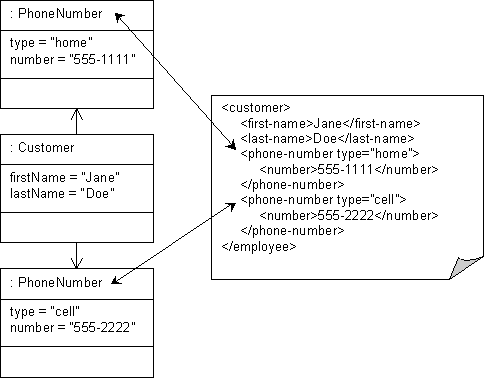Notice: this Wiki will be going read only early in 2024 and edits will no longer be possible. Please see: https://gitlab.eclipse.org/eclipsefdn/helpdesk/-/wikis/Wiki-shutdown-plan for the plan.
EclipseLink/UserGuide/MOXy/Relationships/Privately Owned/One-to-Many
| EclipseLink | |
| Website | |
| Download | |
| Community | |
| Mailing List • Forums • IRC • mattermost | |
| Issues | |
| Open • Help Wanted • Bug Day | |
| Contribute | |
| Browse Source |
One-to-Many Composite Collection Mapping
Use XML composite collection mappings to represent one-to-many relationships. Composite collection XML mappings can reference any class that has an EclipseLink descriptor. The attribute in the object mapped must implement either the Java Collection interface (for example, Vector or HashSet) or Map interface (for example, Hashtable or TreeMap). The CompositeCollectionMapping class allows a reference to the mapped class and the indexing type for that class.
Given the XML schema in this example, XML Composite Collection Mapping illustrates an XML composite collection mapping to different elements by position in a corresponding XML document. Java for XML Composite Collection Mapping for a Collection Attribute shows how to configure this mapping in Java for a Collection attribute and Java for XML Composite Collection Mapping for a Map Attribute shows how to configure this mapping in Java for a Map attribute.
Schema for XML Composite Collection Mapping
<?xml version="1.0" encoding="UTF-8"?> <xsd:schema xmlns:xsd="http://www.w3.org/2001/XMLSchema"> <xsd:element name="customer" type="customer-type"/> <xsd:complexType name="customer-type"> <xsd:sequence> <xsd:element name="first-name" type="xsd:string"/> <xsd:element name="last-name" type="xsd:string"/> <xsd:element name="phone-number"> <xsd:complexType> <xsd:sequence> <xsd:element name="number" type="xsd:string"/> </xsd:sequence> <xsd:attribute name="type" type="xsd:string"/> </xsd:complexType> </xsd:element> </xsd:sequence> </xsd:complexType> </xsd:schema>
<span id="Figure_58-27" /> XML Composite Collection Mapping
<span id="Example_58-49" /> Java for XML Composite Collection Mapping for a Collection AttributeXMLCompositeCollectionMapping phoneNumbersMapping = new XMLCompositeCollectionMapping(); phoneNumbersMapping.setAttributeName("phoneNumbers"); phoneNumbersMapping.setXPath("phone-number"); phoneNumbersMapping.setReferenceClass(PhoneNumber.class);
<span id="Example_58-50" /> Java for XML Composite Collection Mapping for a Map Attribute
XMLCompositeCollectionMapping phoneNumbersMapping = new XMLCompositeCollectionMapping(); phoneNumbersMapping.setAttributeName("phoneNumbers"); phoneNumbersMapping.setXPath("phone-number"); phoneNumbersMapping.setReferenceClass(PhoneNumber.class); phoneNumbersMapping.useMapClass(HashMap.class, "getType");
<span id="annotations" /></span> Using EclipseLink Annotations Use the @OneToMany annotation:
@Entity public class Employee { @OneToMany(mappedBy="contact") private List<PhoneNumber> contactNumber; }
Use the EclipseLink extension @XmlInverseReference to map the back-pointer:
@Entity public class PhoneNumber { @ManyToOne @JoinColumn(name="E_ID", referencedColumnName = "E_ID") @XmlInverseReference(mappedBy="contactNumber") private Employee contact; }
|
|
|
|
| How to contribute to this guide... | ||

